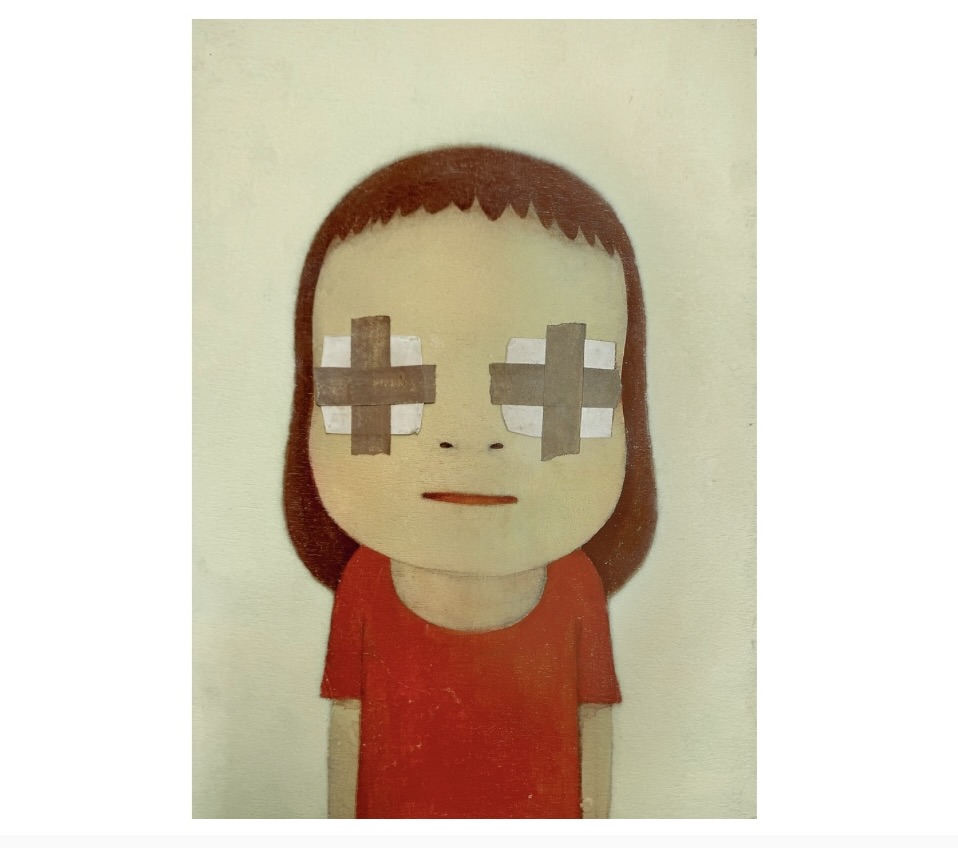Few works of contemporary Asian art encapsulate both vulnerability and defiance as powerfully as Untitled (2012) by Yoshitomo Nara. At first glance, the piece appears deceptively simple: a childlike figure rendered in muted tones, eyes obscured by cross-shaped patches of tape, expression hovering between stoicism and melancholy. Yet beneath this quiet facade lies a rich confluence of cultural history, emotional resonance, and market desirability. For collectors, curators, and scholars alike, this image is not merely another painting in Nara’s oeuvre but a distillation of the qualities that have made him Asia’s “most expensive” contemporary artist at auction.
Nara’s Status in the Global Market
Yoshitomo Nara occupies a unique place in the contemporary art world. While Japanese postwar masters like Yayoi Kusama and Takashi Murakami forged reputations rooted in Pop-infused psychedelia and superflat aesthetics, Nara’s trajectory has been one of intimate confrontation. His childlike figures, often imbued with menace, sadness, or quiet rebellion, have found an extraordinary audience in both East and West.
At auction, Nara’s works consistently command staggering figures. In 2019, Knife Behind Back (2000) sold at Sotheby’s Hong Kong for over USD 25 million, shattering records for contemporary Asian painting. Works featuring solitary children dominate his auction history, making up all of his top ten records. Collectors see in these canvases a near-perfect blend of accessibility, narrative openness, and emotional charge—qualities that make Untitled (2012) emblematic of Nara’s most desirable subject matter.
The Child as Universal Subject
The figure at the heart of Untitled (2012) exemplifies Nara’s enduring fascination with childhood imagery. Far from being sentimental or nostalgic, his children stand as ambiguous archetypes—innocent yet uncanny, fragile yet confrontational. The figure’s disproportionately large head and pared-down features evoke children’s drawings, Japanese manga aesthetics, and European fairytales, but their blank stares or subtle gestures suggest darker undercurrents.
In this work, the obscured eyes strike at the very core of Nara’s language. To cover a child’s eyes with medical tape is to mute perception, to enforce blindness, or to mark a wound. Yet the simplicity of the taped crosses transforms them into symbols of both censorship and protection. The viewer is left to ask: is the child silenced, punished, or shielded? Nara thrives in precisely this ambiguity.
Psychological and Cultural Resonance
Nara’s art often channels his own childhood in postwar Japan, where Western pop culture—punk rock, Disney, and comic books—collided with a national landscape still haunted by collective trauma. This duality surfaces in Untitled (2012)through its tension between sweetness and alienation. The child’s simple red dress and rounded form evoke familiarity, while the clinical obstruction of the eyes injects unease.
From a psychological standpoint, the image resonates with universal themes of vulnerability, repression, and resistance. It taps into the human instinct to empathize with children while unsettling us with their apparent injury. For Japanese audiences, it can also recall cultural anxieties around conformity, where individuality is often restrained. Internationally, the work speaks to broader concerns about surveillance, censorship, and the loss of innocence.
Minimalism Meets Punk Rebellion
Nara’s pared-down aesthetic is not accidental but deeply tied to his punk sensibility. In interviews, he often cites the influence of late 1970s and early 1980s punk rock, whose raw simplicity and anti-authoritarian ethos inspired his visual voice. Untitled (2012) embodies this ethos: flat, graphic surfaces replace elaborate detailing, and the tape crosses act almost like a DIY collage element—reminiscent of punk zines and protest posters.
The muted palette, anchored by the earthy red of the child’s dress, emphasizes restraint. This is rebellion without spectacle, resistance articulated in silence. Unlike Murakami’s polished, glossy superflat works, Nara’s paintings often retain the brush’s physicality and the hand’s imperfection. Collectors interpret this not as lack of refinement but as evidence of authenticity and honesty, traits that make his works resonate even more deeply.
Auction Desirability and Market Psychology
Why does Untitled (2012)—and paintings like it—dominate Nara’s top auction records? Several factors converge:
-
Recognizability: The solitary child figure has become synonymous with Nara’s name, a brand in itself. Collectors prize images that are instantly identifiable.
-
Scale and Simplicity: Unlike his sculptures or large installations, works like this are intimate and displayable, fitting seamlessly into both private collections and museum walls.
-
Emotional Universality: The painting communicates across cultural boundaries, appealing equally to Asian and Western buyers.
-
Scarcity and Demand: Nara’s most iconic works are not only few in number but highly contested at auction, ensuring competitive bidding and escalating prices.
-
Narrative Openness: The ambiguity of the child’s expression and situation invites projection, making the work endlessly interpretable—a crucial trait for longevity in the secondary market.
A Shift in Perception: From Subculture to Blue-Chip
In the 1990s, Nara was often associated with Japan’s subcultural art scene, his images reproduced on posters, album covers, and merchandise. By 2010, however, his reputation shifted dramatically. Major retrospectives—such as the 2010 Asia Society Museum show in New York—positioned him as a serious contemporary master. Collectors who once dismissed him as “low art” began competing for his canvases at Sotheby’s and Christie’s.
Untitled (2012), created during this period of transition, reflects this dual identity: rooted in the aesthetics of underground rebellion yet elevated to the pedestal of blue-chip investment. Its surface, deceptively simple, conceals the depth of its cultural crossover.
Comparison With Other Works
To understand the painting’s significance, it is worth comparing it to other milestone works in Nara’s oeuvre:
-
Knife Behind Back (2000): Here, a small girl hides a weapon, embodying outward innocence with concealed aggression. Its auction success epitomized Nara’s ability to turn vulnerability into menace.
-
Sleepless Night (Sitting) (1997): A sculpture featuring a seated child with oversized head, which demonstrates Nara’s shift from flat imagery to three-dimensional embodiment of his themes.
-
Fountain of Life (2010): A monumental installation created with collaborators, contrasting with the intimacy of Untitled (2012).
Placed against these, Untitled (2012) strikes a balance: intimate in scale yet monumental in emotional charge.
Philosophical Dimensions
The image of a blind or silenced child carries a haunting philosophical weight. It asks whether innocence can survive in a world of imposed restrictions. The cross-shaped patches resemble both bandages and censorship bars, suggesting healing and harm simultaneously. For some, it evokes the Buddhist concept of suffering as inherent to life; for others, it resonates with Western notions of existential alienation.
Nara’s genius lies in this multiplicity. The painting resists closure, instead functioning as a mirror for the viewer’s anxieties and hopes.
Collectors and Institutions
Nara’s works now reside in major collections worldwide—from the Museum of Modern Art in New York to the Aomori Museum of Art in Japan. Untitled (2012), while in private hands, is a type of work highly coveted by institutions seeking to represent 21st-century Asian art history. Its desirability stems from both its aesthetic power and its role in Nara’s larger cultural narrative.
Legacy and Influence
As Asia’s most expensive contemporary artist, Nara’s influence is profound. Younger generations of artists in Japan, Korea, and China draw inspiration from his blend of pop culture, personal narrative, and political undercurrent. His children, often defiant or wounded, stand as emblems of resistance against homogenized global culture.
Untitled (2012) captures this legacy in distilled form: simple yet haunting, personal yet universal, playful yet tragic. It is not only a desirable auction subject but also a touchstone for understanding the trajectory of Asian art in the global marketplace.
Impression
In the end, Untitled (2012) reminds us that power does not always announce itself through grandeur or spectacle. Sometimes it resides in silence, in absence, in the small figure whose eyes are taped shut yet whose presence dominates the canvas.
This is why Nara remains Asia’s most expensive contemporary artist. His works, particularly those featuring solitary children, condense rebellion, vulnerability, and universality into images that continue to haunt collectors and critics alike. In the language of the art market, Untitled (2012) is desirable; in the language of culture, it is unforgettable.
No comments yet.








